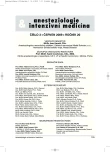Regional cooling of blood in the extracorporeal circuit: New way of anticoagulation during CRRT
Authors:
Kroužecký Aleš 1; Sýkora Roman 1; Chvojka Jiří 1; Karvunidis Thomas 1; Raděj Jaroslav 1; Novák Ivan 1; Růžička Jiří 2; Beneš Jiří 2; Petránková Zuzana 2; Bolek Lukáš 2; Matějovič Martin 1
Authors‘ workplace:
JIP, I. interní klinika, Fakultní nemocnice Plzeň a Univerzita Karlova, Lékařská fakulta v Plzni
1; Ústav biofyziky, Univerzita Karlova, Lékařská fakulta v Plzni
2
Published in:
Anest. intenziv. Med., 20, 2009, č. 3, s. 143-148
Category:
Intensive Care Medicine - Original Paper
Overview
Objective:
To test the hypothesis that cooling of blood in the extracorporeal circuit of continuous veno-venous hemofiltration (CVVH) enables to realize the procedure without the need of anticoagulation.
Design:
Experimental animal study.
Methods:
We developed the device for selective cooling of extracorporeal circuit (20 °C) allowing blood rewarming (38 °C) just before returning into the body. 12 anesthetized and ventilated pigs were randomized to receive either 6 hrs of CVVH with application of this device (COOL; n = 6) or without it (CONTR; n = 6). Before the procedure and in 15., 60., 180., 360. minute after starting hemofiltration variables related to: 1) circuit patency (time to clotting [TC], number of alarm-triggered pump stopping [AS], venous and transmembranous circuit pressures [VP, TMP]); 2) coagulation status in the extracorporeal circuit (thrombin-antithrombin complexes [TATcirc], thromboelastography [TEG]) and 3) animal status (hemodynamics, hemolysis, biochemistry) were assessed.
Results:
The patency of all circuits treated with selective cooling was well maintained within the observation period. By contrast, 5 of 6 sessions were prematurely clotted in the untreated group. As a result, the number of AS was significantly higher in the CONTR group. In-circuit thrombus generation in CONTR group was associated with a markedly increasing TATcirc. TEG performed at 180.minute of the procedure revealed a tendency to a prolonged initial clotting time and a significant decrease in clotting rate of in-circuit blood in the COOL group. No signs of repeated cooling/rewarming-induced hemolysis were observed in animals treated with “hypothermic circuit” CVVH.
Conclusion:
In this porcine model, regional extracorporeal blood cooling proved effective in preventing in-circuit clotting without the need to use any other anticoagulant.
Keywords:
renal replacement therapy, anticoagulation, hypothermia, hemofiltration, cooling, critically ill
Sources
1. Joannidis, M., Oudemans-van Straaten, H. M. Clinical review: Patency of the circuit in continuous renal replacement therapy. Crit. Care, 2007, 11, p. 218–227.
2. Oudemans-van Straaten, H. M., Wester, J. P., de Pont, A. C. et al. Anticoagulation strategies in continuous renal replacement therapy: can the choice be evidence based? Intensive Care Med., 2006, 32, p. 188–202.
3. Tan, H. K., Baldwin, I., Bellomo, R. Continuous veno-venous hemofiltration without anticoagulation in high-risk patients. Intensive Care Med., 2000, 26, p. 1652–1657.
4. Simpson, S., Rasmussen, A. T. The effect of temperature on blood coagulation time. Q. J. Exp. Physiol., 1916, 10, p. 159–168.
5. Rohrer, M. J., Natale A. M. Effect of hypothermia on the coagulation cascade. Crit. Care Med., 1992, 20, p. 1402–1405.
6. Wolberg, A. S., Meng, Z. H., Monroe, D. M. et al. A systematic evaluation of the effect of temperature on coagulation enzyme activity and platelet function. J. Trauma, 2004, 56, p. 1221–1228.
7. Watts, D. D., Trask, A., Soeken, K. et al. Hypothermic coagulopathy in trauma: effect of varying levels of hypothermia on enzyme speed, platelet function, and fibrinolytic activity. J. Trauma, 1998, 44, p. 846–854.
8. Staab, D. B., Sorensen, V. J., Fath, J. J. et al. Coagulation defects resulting from ambient temperature-induced hypothermia. J. Trauma, 1994, 36, p. 634–638.
9. Otte, K. E., Jensen, P. B., Svendsen, P. et al. Heparin-free hypothermal hemodialysis at 20 degrees C improves biocompatibility. Blood Purif., 1997, 15, p. 200–207.
10. Kettner, S. C., Sitzwohl, C., Zimpfer, M. et al. The effect of graded hypothermia (36 degrees C-32 degrees C) on hemostasis in anesthetized patients without surgical trauma. Anesth. Analg., 2003, 96, p. 772–1776.
11. Martini, W. Z. The effects of hypothermia on fibrinogen metabolism and coagulation function in swine. Metabolism, 2007, 56, p. 214–221.
12. Martini, W. Z., Pusateri, A. E., Uscilowicz, J. M. et al. Independent contributions of hypothermia and acidosis to coagulopathy in swine. J. Trauma, 2005, 58, p. 1002–1009.
13. Kermode, J. C., Zheng, Q., Milner, E. P. Marked temperature dependence of the platelet calcium signal induced by human von Willebrand factor. Blood, 1999, 94, p. 199–207.
14. Valeri, C. R., Feingold, H., Cassidy, G. et al. Hypothermia--induced reversible platelet dysfunction. Ann. Surg., 1987, 205, p. 175–181.
15. DeLoughery, T. G. Coagulation defects in trauma patients: etiology, recognition, and therapy. Crit. Care Clin., 2004, 20, p. 13–24.
16. Ao, H., Moon, J. K., Tashiro, M. et al. Delayed platelet dysfunction in prolonged induced canine hypothermia. Resuscitation, 2001, 51, p. 83–90.
17. Velik-Salchner, C., Schnürer, C., Fries, D. et al. Normal values for thrombelastography (ROTEM) and selected coagulation parameters in porcine blood. Thromb. Res., 2006, 117, p. 597–602.
18. Olsen, A. K. The pig as a model in blood and coagulation and fibrinolysis research. Scand. J. Lab. Anim. Sci., 1999, 26, p. 214.
Labels
Anaesthesiology, Resuscitation and Inten Intensive Care MedicineArticle was published in
Anaesthesiology and Intensive Care Medicine

2009 Issue 3
Most read in this issue
- Analgosedation in Intensive Care Units (ICU) in the Czech Republic – the results of questionnaire study
- Delirium during the postoperative period and in the intensive medicine
- Catheter-related blood stream infections
- Dynamic parameters of preload in pressure support ventilation
